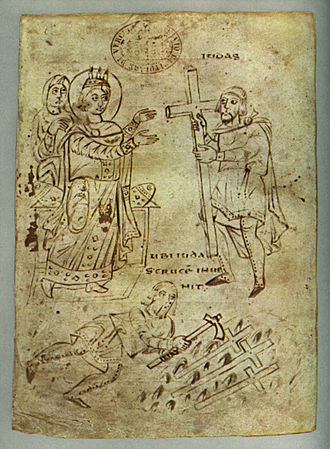Notes on the Office for June.
From 1 Vespers of Trinity Sunday, the Office returns to the 'throughout the year' texts for the Ordinary of the Office.
If you would like more detailed notes, you can purchase the full ordo through Lulu in hardcopy or PDF form.
You can also find notes on how to say the Benedictine Office according to the 1962 calendar and rubrics here.
June 2023
Thursday 1 June – Pentecost Thursday, Class I
Canticle antiphons and collect, MD 405*/AM 529-30.
Friday 2 June – Ember Friday of Pentecost, Class I
Canticle antiphons and collect, MD 405-6*/AM 530-1.
Saturday 3 June – Ember Saturday of Pentecost, Class I
Lauds to None: As for Pentecost Sunday, with festal psalms at Lauds and Vespers, except the Benedictus antiphon and collect, MD 406-7*/AM 531; 1 Vespers of the Most Holy Trinity: Sunday psalms with antiphons, chapter, responsory, hymn, versicle, Magnificat antiphon and collect of the feast, MD 407*/AM 532 ff (no commemoration of the Sunday); Compline: Marian Antiphon Salve Regina, MD 268-9/AM 176 or 180, henceforward.
Sunday 4 June – Feast of the Most Holy Trinity, Class I
MD 409*/AM 535 ff (no commemoration of the Sunday).
Monday 5 June – St Boniface, Class III
MD [152]/AM 914.
Tuesday 6 June – St Norbert, Class III
MD [152]/AM 915.
Wednesday 7 June – Class IV
Collect of the First Sunday after Pentecost, MD 418*/AM 535; 1 Vespers of Corpus Christi, MD 419*/AM 543 ff.
Thursday 8 June – Corpus Christi, Class I [Previously: with a Privileged Octave of the second order]
MD 427*/AM 550 ff.
Friday 9 June – Class IV; SS Primus and Felician, Memorial [**In some places, St Columba]
For the commemoration at Lauds, MD [153]/AM 915.
Saturday 10 June – Class IV; Saturday of Our Lady [EF: St Margaret of Scotland, Class III]
1 Vespers of the Second Sunday after Pentecost, MD 432*/AM 556-7.
Sunday 11 June – Second
Sunday after Pentecost (Sunday within the Octave of Corpus Christi), Class II
MD 461-2*/AM 557-8.
Monday 12 June – Class IV [EF: St John of Facundo; SS
Basilides, Cyrinus, Nabor and Nazarius, Memorial]
All as in the psalter for throughout the year with collect MD 462*/AM 557.
Tuesday 13 June – Class IV; St Anthony of Padua, Memorial [EF: Class III]
For the commemoration at Lauds, MD [154]/AM 916.
Wednesday 14 June – St Basil the Great, Class III
MD [155]/AM 917.
Thursday 15 June – Class IV; St Vitus, Memorial [EF/Gower: also SS Modestus and Crescentia, Memorial]
For the commemoration at Lauds, MD [155]/AM 917; 1 Vespers of the Sacred Heart, MD 432*/AM 560 ff.
Friday 16 June – Feast of the Most Sacred Heart of Jesus, Class I [Previously: with a Privileged Octave of the third order]
MD 439*/AM 565 ff.
Saturday 17 June – Class IV; Saturday of Our Lady [EF: St Gregory Barbarigo, Class III]
1 Vespers of the Third Sunday after Pentecost, MD 445*/AM 571.
Sunday 18 June – Third
Sunday after Pentecost (Sunday within the Octave of the Sacred Heart of Jesus),
Class II
MD 462-3*/AM 571 ff.
Monday 19 June – Class IV; St Gervase and Protase, Memorial [EF: St Juliana Falcionieri, Class III]
All as in the psalter for time throughout the year with collect, MD 463*/AM 572; for the commemorations at Lauds, MD [157]/AM 918.
Tuesday 20 June – Class IV [EF: St Silverius, Memorial]
Wednesday 21 June – Class IV; St Aloysius Gonzaga, Memorial [EF: Class III]
For the commemoration at Lauds, MD [157-8]/AM 918.
Thursday 22 June – Class IV [EF/Gower: St Paulinus, Memorial; in England and Wales, SS John Fisher and Thomas More]
Friday 23 June – Vigil of the Nativity of St John the Baptist, Class II
MD [158]/AM 919; 1 Vespers of the Nativity of St John the Baptist, MD [159]/AM 920 ff.
Saturday 24 June – Nativity of St John the Baptist, Class I [Previously: with a Common Octave]
MD [161]/AM 924 ff; 2 Vespers of the feast with commemoration of the Fourth Sunday after Pentecost, MD 445*/AM 575-6 & 593.
Sunday 25 June – Fourth
Sunday after Pentecost, Class II
MD 463-4*/AM 593.
Monday 26 June – Class IV; SS John and Paul, Memorial [EF: Class III]
For the commemoration at Lauds, MD [166]/AM 929.
Tuesday 27 June – Class IV
Wednesday 28 June – Vigil of SS Peter and Paul, Class II
MD [166-7]/AM 930; 1 Vespers of SS Peter and Paul, MD [167]/AM 931 ff.
Thursday 29 June – SS Peter and Paul, Class I [Previously: with a Common Octave]
MD [169]/AM 934 ff.
Friday 30 June – Commemoration of St Paul, Class III
